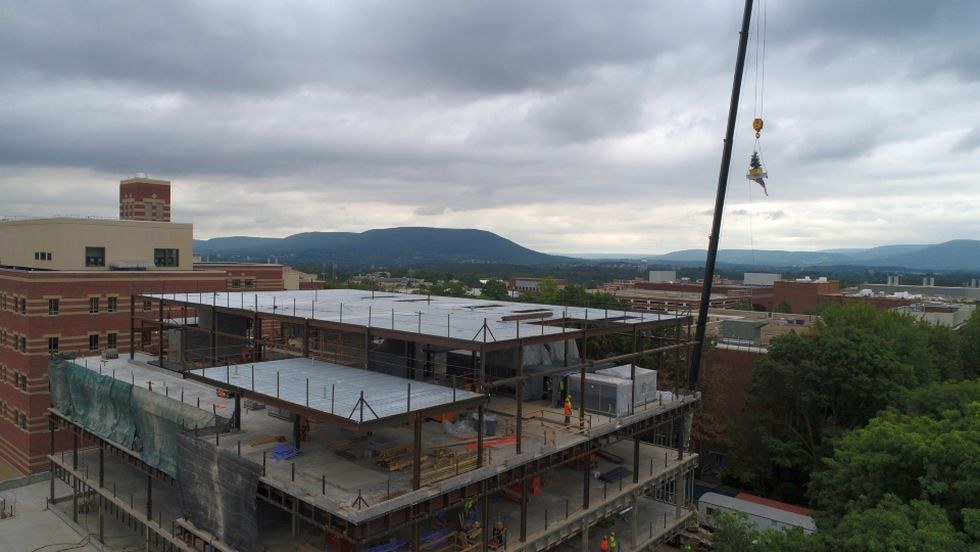Posted: September 14, 2020
A "topping out" ceremony was held to mark the halfway point of construction. The new building, replacing the Henning Building, is expected to be complete in late 2021.

The final beam, with a small tree attached, is hoisted to the top of the half-completed Animal, Veterinary and Biomedical Sciences Building on the University Park campus. The facility is expected to be completed in late 2021. IMAGE: Michael Houtz
UNIVERSITY PARK, Pa. - Leaders from Penn State's College of Agricultural Sciences and Office of Physical Plant, the HOK architectural firm, and Turner Construction Co. on Sept. 11 held a ceremony to mark the halfway point of construction of the Animal, Veterinary and Biomedical Sciences Building on the University Park campus.
Due to the COVID-19 pandemic, organizers limited the attendance at the traditional "topping out" ceremony, at which all participants wore masks and practiced social distancing. The event also was livestreamed for remote viewing.
The building, located on the site of the former Henning Building on Shortlidge Road between Curtin Road and Park Avenue, is expected to be completed in late 2021. The 105,000-square-foot, $98.5 million facility will house research laboratories, instructional spaces and offices for the Animal Science and the Veterinary and Biomedical Sciences departments in the College of Agricultural Sciences.
Rick Roush, dean of the College of Agricultural Sciences, pointed out that the two departments combined enroll more than 680 undergraduate and 100 graduate students and conduct transdisciplinary research that provides real-world solutions, many of which are delivered throughout Pennsylvania and beyond via Penn State Extension programming.
"Animal production is the largest sector of Pennsylvania agriculture, with more than 80,000 jobs," Roush said. "About 29% of agricultural employment is directly related to animal production and the crop production that supports it, providing more than $9 billion to the Pennsylvania economy - and growing."
Roush noted that the departments of Animal Science and Veterinary and Biomedical Sciences are major contributors to this success, but the departments' educational and research programs increasingly were hampered by the obsolete design and failing infrastructure of the now-demolished Henning Building.
"But this new Animal, Veterinary and Biomedical Sciences Building will provide us the opportunity, indeed the obligation, to do more," he said. "Our discovery research and our students will contribute to a safe, affordable and abundant food supply, while helping to mitigate environmental impacts of food and animal production and enhancing animal and human health."
Jeff Spackman, facilities project manager in the Office of Physical Plant, explained that a topping out ceremony, a milestone that usually marks the halfway point of a building project, is a centuries-old tradition in the timber frame construction industry that involves placing of the last beam on top of the structure.
"In ancient Scandinavian culture, the topping out of a building included the placement of a tree on top of the new building to appease the tree-dwelling spirits displaced by that construction, and hence the placement of a small tree on the beam [being raised today]," he said.
Spackman also described the time capsule that will be placed at ground level within the building structure. Scheduled to be opened in 50 years, the capsule contains brochures, articles and other items related to the new building and to the era in which it was built, such as current culture and events - including the coronavirus pandemic.
Kevin Cook, general manager of Turner Construction's Philadelphia office, praised crews for maintaining progress on the building during the COVID-19 crisis.
"I'd be remiss if I didn't thank all the people who have continued to work diligently and safely through the pandemic to keep the project going," he said. "This is an opportunity for Turner to construct a space that the students are going to really enjoy, but also an opportunity for us to continue our partnership with Penn State in building great new science facilities like this one."
The new structure gives scientists a chance to reinvent their research programs by "building" their own labs, said Ken Drucker, design principal for HOK.
"Working with this campus is very important to us because everybody treats Happy Valley - and the landscape, and the creation of public spaces - as a responsibility," Drucker said. "We also feel like we have a responsibility to create great spaces for science, and this project represents an opportunity to create a piece of architecture that becomes part of the fabric of the campus."

